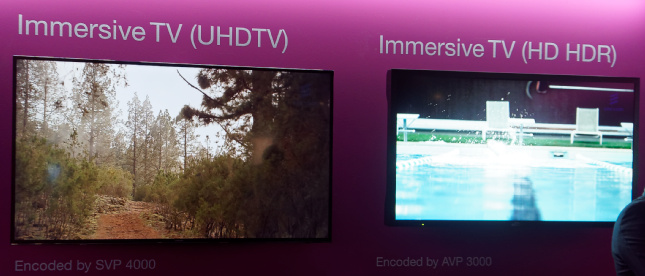We met up with Matthew Goldman, the Senior VP Technology at Ericsson and had a good chat about HDR and the issues. We also recorded an interview with him, look here for updates when that is processed.
Ericsson is clear that 1080P 50 video with HDR and WCG is a better experience for most consumers at normal viewing distance than UltraHD with just a boost in spatial resolution, although even better is the spatial resolution together with HDR. Ericsson is calling this UltraHD+ (although some are worried that such terms will cause confusion to buyers – Man. Ed.). Goldman expects HDR important for broadcast from 2017 onwards (which matches the DVB view – Man. Ed.). The firm was showing an impressive demonstration of HDR at 1080P compared to SDR on the booth – with 4:2:2 colour.
 Ericsson showed a demo of SDR with UHD resolution vs HDR and FullHD resolution
Ericsson showed a demo of SDR with UHD resolution vs HDR and FullHD resolution
Goldman said that the difference is even more important for broadcasters because bits cost money and HDR delivers “More Bang per Bit” than UltraHD resolution. While spatial resolution boosts bitrates by 2.5X, HDR may add just up to a maximum of 20%.
Goldman pointed out that if a consumer goes into a store to buy a high end TV and an audio system, they will probably get advice on how to set up the audio system, but none relating to how to set up the display for optimal viewing – which should be much closer for UltraHD resolution. While HD is best watched from three times the picture height, so normal viewing distances are fine for a 50″ (125cm) to 60″ (150cm) display. If furniture is where it was and you don’t buy a bigger set – you’ll just have a great FullHD experience. He also pointed out that while today’s upscalers in sets are very good, the de-interlacers may not be so good.
Of course, this gets even worse at 8K, where you need to be just 0.75 times the screen height away from the display
He also believes that object-based and immersive audio will be important, along with HEVC as a critical component in limiting the bandwidth needs for UltraHD.
We talked at some length about different HDR technologies for contribution and Goldman is clear that anything with metadata or dual layers is potentially an issue for live broadcast. Broadcast is not just about the video, you have a lot of added graphics, blue-screening, etc and the workflow really has to be similar to today for it to work in live broadcasting. Off-line content, such as optical or OTT may be a different issue.
At the show, Ericsson was also demonstrating, for the first time worldwide, the use of the firm’s AVP3000 encoder for contribution of content with HDR via a satellite using DVB-SX2 to broadcast via satellite in cooperation with Intelsat. The codec was H.264 and we heard that there is a “modest overhead” to add HDR.

